The Digital Sensor: A Guide to Understanding Digital Cameras
by Wesley Fink on April 21, 2008 1:00 AM EST- Posted in
- Digital Camera
Bayer vs. Foveon
This title is something of a misstatement, as it would more accurately be Foveon/Sigma versus everyone else in the world. All DSLR imaging sensors except the Foveon use Bayer technology. Digital color images are created by capturing red, blue, and green pixels and then combining them to create a full color image.
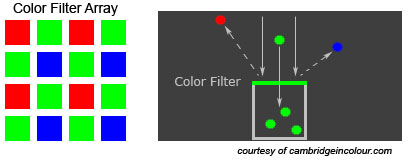
All current sensors except one use Bayer technology. The sensor consists of X megapixels, or light gathering cavities. The sensor is covered with a Bayer array, which is a series of microlenses that allow only certain colors to fall in certain cavities (or pixels). The microlenses are arranged in a defined grid that consists of alternating red-green and green-blue filters.
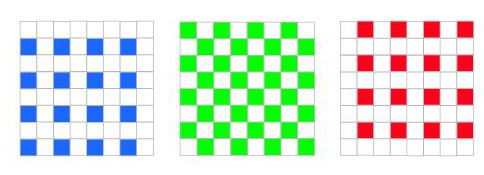
If you noticed there are twice as many green as red or blue areas in the above image, that is by design in the Bayer array. The human eye is more sensitive to green light than red or blue and the Bayer array uses this fact to produce images that appear to have finer detail and less noise. The doubling of the green receptors is corrected in the image processing.
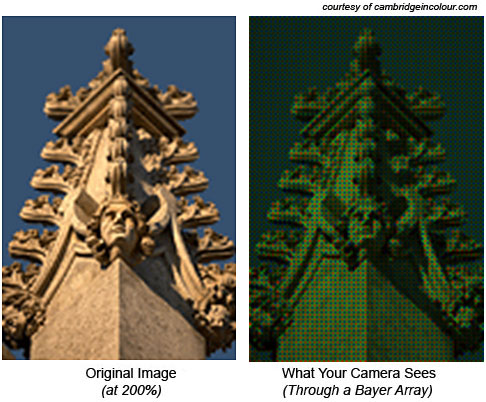
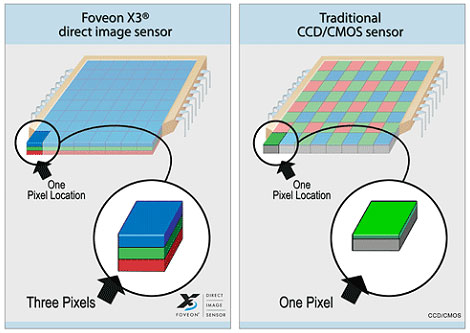
There is no demosaicing or interpolation step with the Foveon sensor. Where before there was one pixel of color information, the Foveon is now capturing red, green, and blue data pixels in the same pixel location. On the surface, this certainly appears a superior way of capturing color images, but things are not always as they appear. It is fair to ask: if this approach is so good then why is Sigma, a minor player in the digital camera market, the only company to embrace the Foveon sensor? A closer look at Foveon specs helps to understand some of the issues.
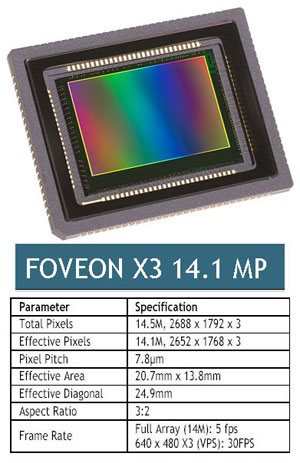
The top current Foveon sensor is the 14.1MP Foveon used in the Sigma SD14 digital camera. Foveon gets to the 14.1MP total by counting all pixels used to create the finished image, which is 2688x1768 pixels or 4.7MP. Many would argue this is fair since each pixel in a competing 14.1MP is only collecting one piece of color information. However, the practical reality is that a 14.1MP Foveon is reported to be about equivalent to an 8MP Bayer DSLR when shooting JPEGs and about as good a 10MP camera when shooting in the preferred and native RAW mode. The apparent resolution then is somewhere between the 4.7MP image size and the 14.1MP that are used to create that image.
Several other issues have also held back Foveon. Where the best Bayer cameras can now capture useful images at ISO 1600, 3200, or even higher, the Foveon sensor is best at lower ISOs. It is usable to about ISO 400 and then noise climbs rapidly as the ISO increases. The latest SD14 Foveon is reported to be better in ISO sensitivity, but it still falls far short of the extended ISO performance of its competition.
The other major issue with the Foveon sensor is that the separation into 3 distinct colors for each pixel site is not nearly as straightforward as Foveon describes it. The captured image still requires a lot of image processing to extract the 3 colors from each pixel site and reconstruct the finished image. In fact some critics claim the image processing required by the Foveon sensor is even more extensive than Bayer Array demosaicing. The purer the data in any extraction process the more faithful it is to the original capture, so the Foveon sensor may offer fewer "post-processing" advantages than it first appears. When conditions and lighting are correct the Foveon can deliver stunning images, but things in photography are rarely perfect.
For the purpose of our discussion the Foveon is more a novelty than a sensor you will likely use today. Despite its limited availability, however, the concept of the Foveon sensor is as compelling as ever, and you can actually buy a production camera, the Sigma SD14, that uses this sensor. As you can see from the specs, the sensor size is 20.7x13.8mm, which places the Foveon between the Canon small APS C and the Olympus 4/3 sensor. The lens multiplier is 1.7X.










72 Comments
View All Comments
Johnmcl7 - Monday, April 21, 2008 - link
I do agree with you there that it is desirable to have deeper depth of field (particularly on macro) but I think the difference is that on an SLR you have the choice - you can shoot wide open and have shallow depth of field or you can stop down (and normally have to use up the ISO advantage) to get depth of field. On a camera with a small sensor you are generally stuck with the deep depth of field whether you want it or not.John
finbarqs - Monday, April 21, 2008 - link
I hope nobody is using F/1.2 when shooting a portrait. Unless you want only a nose to be in focus. With something THAT shallow, you either have to REALLY step back and use distance to your advantage to get what you want in Focus. Professional Wedding photographers will not TOUCH anything above f/5.6 as you don't want to get ONLY the bride in focus while the groom is OOF.People, remember there are multiple factors that affect DOF. Aperture is definitely one of them, distance, and Focal Length.
Obviously you want something very shallow with great bokeh, then you would get close to your subject, open up your aperture, and have a telephoto focal length.
The thing is, on a FF sensor, you "see more" on the same focal length as a cropped sensor. Well put wesley, a 50mm is a 50mm. For those of us with cropped sensors, slap a 50mm on your camera. (or zoom to 50mm). Look at your subject with your naked eye, then look through the view finder. SAME SIZE AND SHAPE! Nothing gets larger! Supposedly a telephoto range (greater than normal) should have some zoom effets shouldn't it? I mean APS-C sensors are either 1.5 or 1.6 smaller than a full frame, that means the normal focal length should be around 27mm? So 50mm should be 75mm for nikons and 80mm for canons! That means you should see some zoom in 50mm! but nope! you don't! in fact, the only time you'll see the zoom is AFTER you fire the shutter and it displays the image to fill that 2.5" or 3.0" inch lcd you have! (or even 2.0") So where does the FF excel? you place 2 cameras exactly side by side of each other, same focal length, same focus point. Same lens. Through the Viewfinder, you'll see the nice Bokeh of your subject on BOTH cameras, exactly the same. Difference? the FF has more frame coverage! Thus, having better "DOF" (or lack thereof) because of the more frame coverage! On this note, let's all by Hasselblad's Medium FF and get some nice digital backs! ;)
haplo602 - Tuesday, April 22, 2008 - link
Hmm ... In my understanding the difference in FF to APS-C is CROP.A 50mm lens on APS-C has the same DOF, same perspective characteristic as on a FF camera, but the sensor is smaller, so you basicaly get a CROP of the original FF image. There is only a perceived zoom effect as the image is a smaller area.
For Nikon you get 1.5x smaller image area, but everything else is the same as on FF.
melgross - Tuesday, April 22, 2008 - link
It has to do with distance from the subject as well. Perspective is the ratio of the distance to the subject to the distance to the background.So, to get the same size on sensor, with the same lens length, you must either move closer, or further, changing the perspective, and the depth of field.
finbarqs - Monday, April 21, 2008 - link
Medium Format* sorry, typo :)Johnmcl7 - Monday, April 21, 2008 - link
Other way round - a larger sensor gives you *less* depth of field which as you quite rightly point out is a strong advantage of a larger sensor.John
pinto4402 - Monday, April 21, 2008 - link
DOF is also a function of the lens. Some ultra-serious photographers are willing to pay $2500 for a Canon 85mm 1.2L over a 85mm 1.8 (which is just as sharp and which only retails for $300), because the 1.2L has a softer, more pleasing DOF effect.TETRONG - Monday, April 21, 2008 - link
Cool article.Looking to buy a camera pretty soon here.
What do you folks think about the G9?
Is there a particular brand I should favor?
Also, are there any cameras available that do "tricky" stuff, like Infrared, Macro, or that neat effect when cities look miniature? (Can't find an example)
I read an article about a guy a few years back that would setup a scene, then he would walk around selectively lighting certain aspects in trippy ways to make a final composite image.
Anyone know what this is called, or where I can learn more about it?
Much obliged!
strikeback03 - Tuesday, April 22, 2008 - link
Is "fisheye" what you are looking for for the miniature cities?and the selective lighting is often called "Painting with light"
plenty of compact cameras can do OK macro if you can get really close to your subject, but as this is often hard for reasons of lighting and/or scaring off the subject, an SLR with a real macro lens is still beneficial.
pinto4402 - Monday, April 21, 2008 - link
There was an article at http://www.popphoto.com/popularphotographyfeatures...">http://www.popphoto.com/popularphotogra.../4923/th...about infrared photography. It also discusses a company that is modifying certain digital cameras for infrared use.